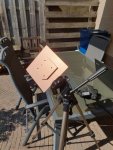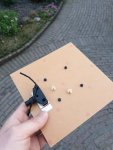Remon
Newbie
Good day,
I can use some help to better understand circular polarization. I have been reading dozens of websites, blogs, forum posts and they all have conflicting information. The more I read the more confused I get.
Let start explaining myself:
I started with AERO and STB-C on L-band Inmarsat a week ago. I got great signals with Adam's (9A4QAV) patch antenna design I made from single sided copper plated pcb and a Nooelec sawbird. The only difference is that I used plastic spacers to make an isolated version of this antenna.
First thing I noticed is that I have to rotate my antenna 90 degrees for best results. No big deal so far.
I instantly got enthusiastic about satcom reception and I was thinking to buy a tripod and dish. Maybe even make and experiment with more antenna designs like a helical antenna.
At this point I got confused: some people (even on reliable websites) say you have to mirror the polarization when you point an antenna to a dish. From this people some say you can do so by rotating your antenna 90 degrees.
In my opinion you have to change the feedpoint of the antenna to do this. I already was planning to add a second SMA connector to my patch antenna to make it compatible with both LHCP and RHCP. Another option would be rotating the front part of the patch antenna.
What makes me "worry": is my antenna (based on Adam's design) polarized the wrong way because I have to rotate it, or is rotating just a part of pointing an antenna?
I tried to imagine how the corkscrew like spiral is beamed to earth and how to pick it up. But I keep scratching my head when I keep finding contradictory information.
Summary of my questions:
Why do I have to rotate my RHCP patch antenna to receive a RHCP signal? Do I change it the LHCP this way and is the Inmarsat signal LHCP? Shouldn't I change the antenna design to make it LHCP?
If any of above question doesn't apply: what is the point of rotating the antenna if the signals is not vertical or horizontal polarized but circular instead?
Do I have to mirror and change polarization when using a dish to point the antenna at?
I can use some help to better understand circular polarization. I have been reading dozens of websites, blogs, forum posts and they all have conflicting information. The more I read the more confused I get.
Let start explaining myself:
I started with AERO and STB-C on L-band Inmarsat a week ago. I got great signals with Adam's (9A4QAV) patch antenna design I made from single sided copper plated pcb and a Nooelec sawbird. The only difference is that I used plastic spacers to make an isolated version of this antenna.
First thing I noticed is that I have to rotate my antenna 90 degrees for best results. No big deal so far.
I instantly got enthusiastic about satcom reception and I was thinking to buy a tripod and dish. Maybe even make and experiment with more antenna designs like a helical antenna.
At this point I got confused: some people (even on reliable websites) say you have to mirror the polarization when you point an antenna to a dish. From this people some say you can do so by rotating your antenna 90 degrees.
In my opinion you have to change the feedpoint of the antenna to do this. I already was planning to add a second SMA connector to my patch antenna to make it compatible with both LHCP and RHCP. Another option would be rotating the front part of the patch antenna.
What makes me "worry": is my antenna (based on Adam's design) polarized the wrong way because I have to rotate it, or is rotating just a part of pointing an antenna?
I tried to imagine how the corkscrew like spiral is beamed to earth and how to pick it up. But I keep scratching my head when I keep finding contradictory information.
Summary of my questions:
Why do I have to rotate my RHCP patch antenna to receive a RHCP signal? Do I change it the LHCP this way and is the Inmarsat signal LHCP? Shouldn't I change the antenna design to make it LHCP?
If any of above question doesn't apply: what is the point of rotating the antenna if the signals is not vertical or horizontal polarized but circular instead?
Do I have to mirror and change polarization when using a dish to point the antenna at?



